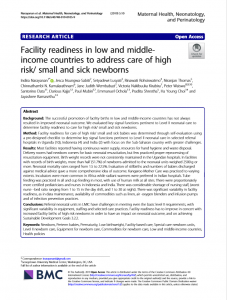
Background
The successful promotion of facility births in low and middle-income countries has not always resulted in improved neonatal outcomes. We evaluated key signal functions pertinent to Level II neonatal care to determine facility readiness to care for high risk/ small and sick newborns.
Methods
Facility readiness for care of high risk/ small and sick babies was determined through self-evaluation using a pre-designed checklist to determine key signal functions pertinent to Level II neonatal care in selected referral hospitals in Uganda (10), Indonesia (4) and India (2) with focus on the Sub-Saharan country with greater challenges.
Results
Most facilities reported having continuous water supply, resources for hand hygiene and waste disposal. Delivery rooms had newborn corners for basic neonatal resuscitation, but few practiced proper reprocessing of resuscitation equipment. Birth weight records were not consistently maintained in the Ugandan hospitals. In facilities with records of birth weights, more than half (51.7%) of newborns admitted to the neonatal units weighed 2500 g or more. Neonatal mortality rates ranged from 1.5 to 22.5%. Evaluation of stillbirths and numbers of babies discharged against medical advice gave a more comprehensive idea of outcome. Kangaroo Mother Care was practiced to varying extents. Incubators were more common in Africa while radiant warmers were preferred in Indian hospitals. Tube feeding was practiced in all and cup feeding in most, with use of human milk at all sites. There were proportionately more certified pediatricians and nurses in Indonesia and India. There was considerable shortage of nursing staff, (worst nurse –bed ratio ranging from 1 to 15 in the day shift, and 1 to 30 at night). There was significant variability in facility readiness, as in data maintenance, availability of commodities such as linen, air -oxygen blenders and infusion pumps and of infection prevention practices.
Conclusions
Referral neonatal units in LMIC have challenges in meeting even the basic level II requirements, with significant variability in equipment, staffing and selected care practices. Facility readiness has to improve in concert with increased facility births of high risk newborns in order to have an impact on neonatal outcome, and on achieving Sustainable Development Goals 3.2.2.